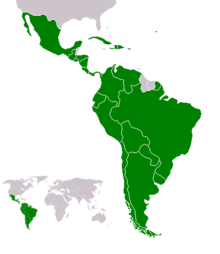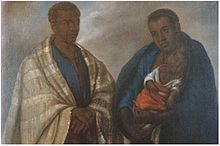آمریکاییهای لاتینتبار سیاهپوست
Afrolatinoamericanos | |
|---|---|
| کل جمعیت | |
| ح. 37.2 million[نیازمند منبع] | |
| مناطق با جمعیت چشمگیر | |
| 14,517,961[۱] | |
| 8,583,759[۲] | |
| 4,671,160[۳] | |
| 1,386,556[۴] | |
| 1,126,894[۵] | |
| 1,087,427[۶] | |
| 1,029,535[۷] | |
| 1,041,559[۸] | |
| 828,841[۹] | |
| 700,000[۱۰] | |
| ۶۲۳٬۰۵۳[۱۱] | |
| ۴۶۱٬۹۹۸[۱۲] | |
| ۳۹۰٬۰۰۰[۱۳] | |
| ۳۰۰٬۰۰۰[۱۴] | |
| ۲۸۴٬۰۰۰[۱۵] | |
| ۱۴۹٬۴۹۳[۱۶] | |
| ۱۰۰٬۰۰۰[۱۷] | |
| ۱۰۰٬۰۰۰[۱۸] | |
| ۴۰٬۰۰۰[۱۹] | |
| زبانها | |
| زبان پرتغالی، زبان اسپانیایی، زبان فرانسوی، زبان انگلیسی and several کریول | |
| دین | |
| مذاهب آفریقایی- امریکایی, مسیحیت (عمدتاکلیسای کاتولیک، با یک اقلیت پروتستانتیسم) یا بیدینی | |
| قومیتهای وابسته | |
| فهرست گروههای قومی در قاره آفریقا، Afro-American peoples of the Americas, Black Hispanic and Latino Americans, آفریقاییهای کارائیب | |
آمریکاییهای آفرو-لاتین یا آمریکای لاتین تبار سیاهپوست (گاهی اوقات آفرو-لاتینها [۲۰] یا آفرو-لاتینکس)،[۲۱][۲۲][۲۳] آمریکاییهای لاتین تبار تبار کامل یا جزئی سیاهپوست هستند.
اصطلاح آمریکاییهای آفرو– لاتین در آمریکای لاتین خارج از محافل دانشگاهی بهطور گستردهای استفاده نمیشود. بهطور معمول به آمریکاییهای آفرو – لاتین سیاه (اسپانیایی: negro ; پرتغالی: negro یا preto ;[۲۴] فرانسوی: noir) گفته میشود.[۲۵] از آمریکاییهای لاتین از آفریقاییتبار ممکن است با پیشوند آفرو- به علاوه یک ملیت خاص، : 3–4 مانند آفرو-برزیلی،[۲۶] آفرو-کوبایی یا آفرو-هاییتیایی یاد شود. [۲۷]
صحت گزارش آماری در مورد آمریکاییهای آفرو- لاتین زیر سؤال رفتهاست، خصوصاً در مواردی که آنها از گزارشهای سرشماری اخذ میشوند و در آن افراد عنوان خود را انتخاب میکنند، زیرا در کشورهای مختلف مفهوم تبار آفریقایی با نگرشهای مختلف مشاهده میشود.[۲۶][۲۰]


منابع[ویرایش]
- ↑ "Censo Demográfico 2010: Características da população e dos domicílios" [Census 2010: Population characteristics and households] (PDF). Brazilian Institute of Geography and Statistics (به پرتغالی). 2010. Retrieved 24 January 2016.
- ↑ "Archived copy". Archived from the original on 29 January 2016. Retrieved 2016-01-24.
{{cite web}}: نگهداری یادکرد:عنوان آرشیو به جای عنوان (link) - ↑ https://www.dane.gov.co/files/investigaciones/boletines/grupos-etnicos/presentacion-grupos-etnicos-poblacion-NARP-2019.pdf
- ↑ "Principales resultados de la Encuesta Intercensal 2015 Estados Unidos Mexicanos" (PDF). INEGI. p. 77. Archived from the original (PDF) on 10 December 2015. Retrieved 9 December 2015.
- ↑ "Oficina Nacional de Estadística e Información, Sitio en Actualización |". Oficina Nacional de Estadística e Información, Sitio en Actualización.
- ↑ "Resultado Básico del XIV Censo Nacional de Población y Vivienda 2011" (PDF). Ine.gov.ve. May 2014. p. 29. Retrieved 8 September 2014.
- ↑ Pons, Frank Moya (2010). Historia de la República Dominicana. google.ro. ISBN 9788400092405.
- ↑ "Censo revela aumento de población afro e indígena". eluniverso.com. 11 October 2011. Retrieved 29 March 2018.
- ↑ "Perú: Perfil Sociodemográfico" (PDF). Instituto Nacional de Estadística e Informática. p. 216.
- ↑ "What is the Afro presence in Nicaragua today?". Creador Pictures. 2009. Archived from the original on 12 October 2011.
- ↑ "Central America :: Panama — The World Factbook - Central Intelligence Agency". www.cia.gov.
- ↑ "Census.gov" (PDF).
- ↑ "¿Cuál es la influencia africana en la cultura, música, religión y tradiciones Costarricenses?" [What is the African influence on culture, music, religion and Costa Rican traditions?]. Creador Pictures (به اسپانیایی). 2009. Archived from the original on 9 January 2014.
- ↑ "Raíces afro Uruguayas" [Afro-Uruguayan roots]. Creador Pictures (به اسپانیایی). 2009. Archived from the original on 27 September 2013.
- ↑ "Honduras". CIA World Factbook. Retrieved 30 October 2016.
- ↑ Perfil, Redacción (28 March 2015). "Los afro- argentinos y el racismo que perdura". Perfil.com.[پیوند مرده]
- ↑ "Si bien la población más grande de garífunas se encuentra en Honduras, también hay presencia garífuna en Guatemala" [While the largest Garifuna population is in Honduras, there are also Garifuna present in Guatemala]. Creador Pictures (به اسپانیایی). 2009. Archived from the original on 9 January 2014.
- ↑ "Afrolatinos, the untaught history, roots: Chile". Creador Pictures. 2009. Archived from the original on 27 January 2010.
- ↑ "¿Son los afrobolivianos incluidos en los censos nacionales? El equipo de 'Afro-Latinos' investigará porqué en 2001 la población negra de Bolivia no fue tenida en cuenta como parte de la población nacional. ¿Cuáles son las condiciones de vida de los afrobolivianos? ¿Es visible la comunidad afroboliviana? ¿Tiene voz?" [Are Afro-Bolivians included in the national census? The 'Afro-Latinos' team investigate why in 2001 the black population of Bolivia was not taken into account as part of the national population. What are the living conditions of Afro-Bolivians? Are the Afro-Bolivian community visible? Do they have a voice?]. Creador Pictures (به اسپانیایی). 2009. Archived from the original on 9 January 2014.
- ↑ ۲۰٫۰ ۲۰٫۱ Seelke, Clare Ribando (November 21, 2008). "CRS Report for Congress: Afro-Latinos in Latin America and Considerations for U.S. Policy" (PDF). Congressional Research Service. Retrieved 15 October 2015.
- ↑ Vidal-Ortiz, Salvador; Mártinez, Juliana (2018). "Latinx thoughts: Latinidad with an X" (PDF). Latino Studies. 16: 384–395. doi:10.1057/s41276-018-0137-8.
- ↑ Alford, Natasha S. (October 4, 2018). "More Latinas Are Choosing to Identify as Afro-Latina". The Oprah Magazine.
- ↑ Velez, Ashley (October 15, 2019). "Here's How the Merriam-Webster Dictionary is Erasing Black Latinxs". The Root.
- ↑ "Características Étnico-raciais da População" (PDF). biblioteca.ibge.gov.br. 2021-02-24. Retrieved 2021-05-22.
- ↑ «آفرو؛ سبک مو نماد مبارزه علیه نژادپرستی». BBC News فارسی. ۲۰۲۱-۰۳-۰۸. دریافتشده در ۲۰۲۱-۱۱-۱۹.
- ↑ ۲۶٫۰ ۲۶٫۱ Loveman, Mara; Muniz, Jeronimo O.; Bailey, Stanley R. (2011). "Brazil in black and white? Race categories, the census, and the study of inequality" (PDF). Ethnic and Racial Studies. 35 (8): 1466–1483. doi:10.1080/01419870.2011.607503. Archived from the original (PDF) on 2 February 2014. خطای یادکرد: برچسب
<ref>نامعتبر؛ نام «autogenerated1466» چندین بار با محتوای متفاوت تعریف شده است. (صفحهٔ راهنما را مطالعه کنید.). - ↑ خطای یادکرد: خطای یادکرد:برچسب
<ref> غیرمجاز؛ متنی برای یادکردهای با نامMadrigalوارد نشده است. (صفحهٔ راهنما را مطالعه کنید.).
